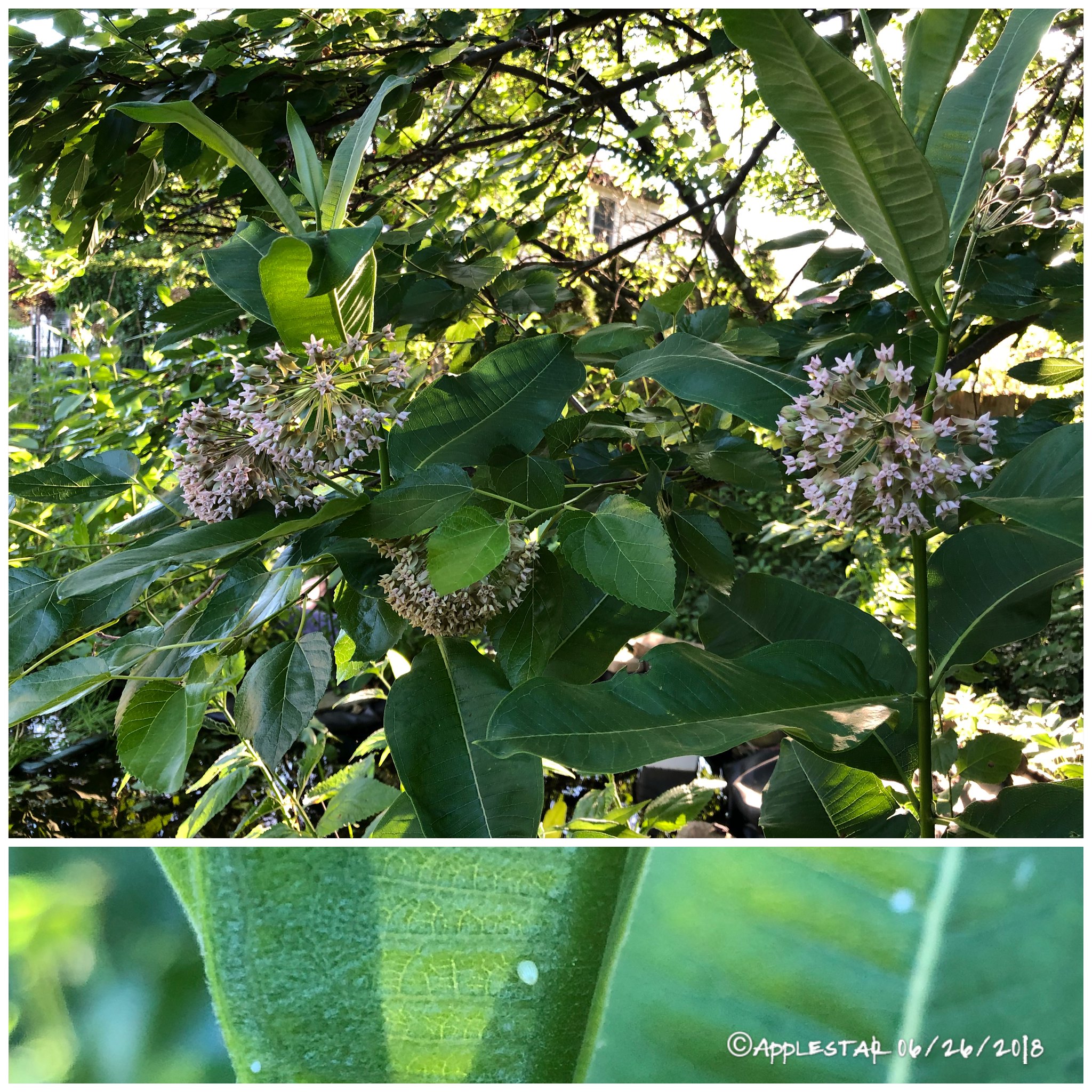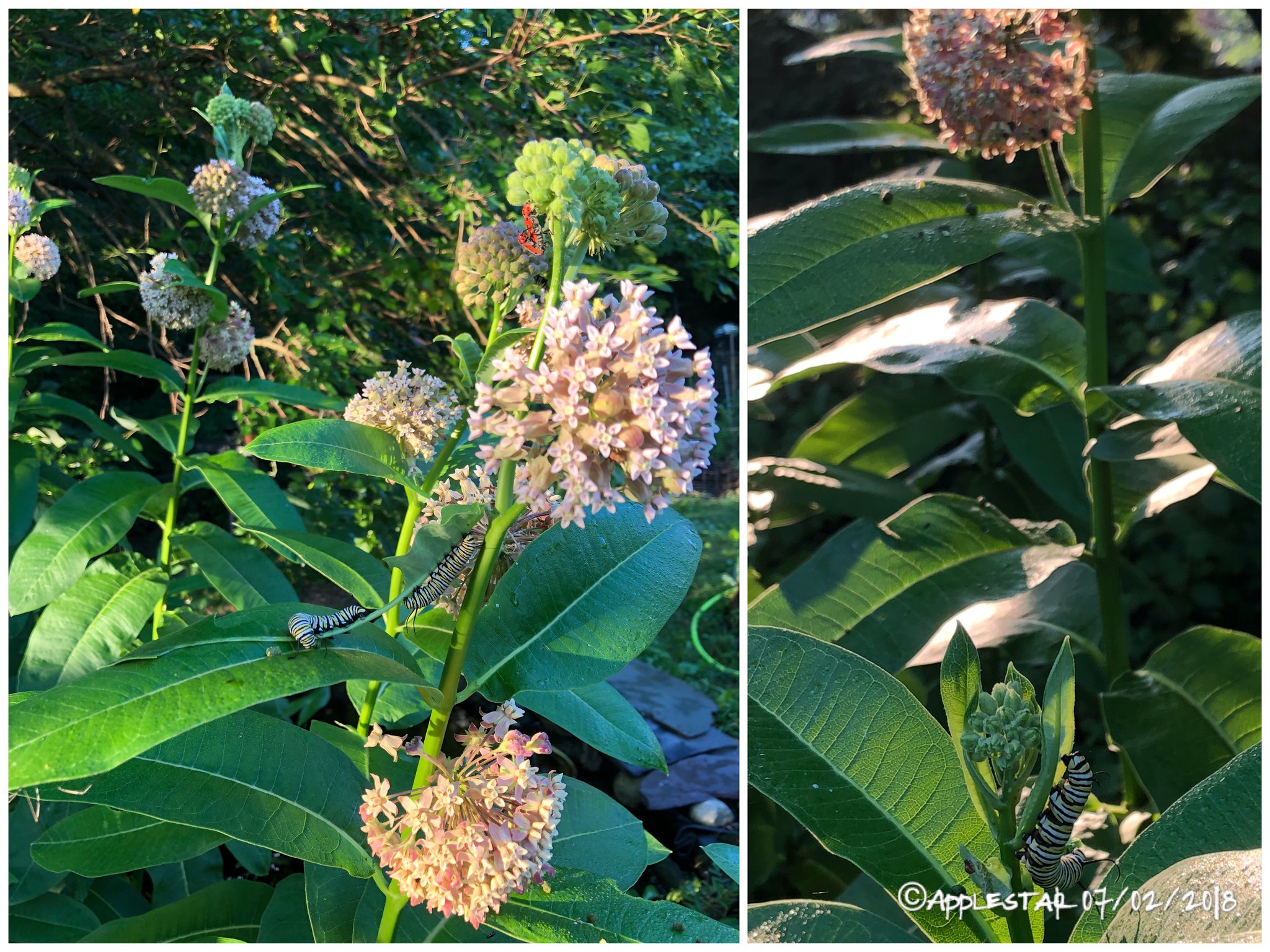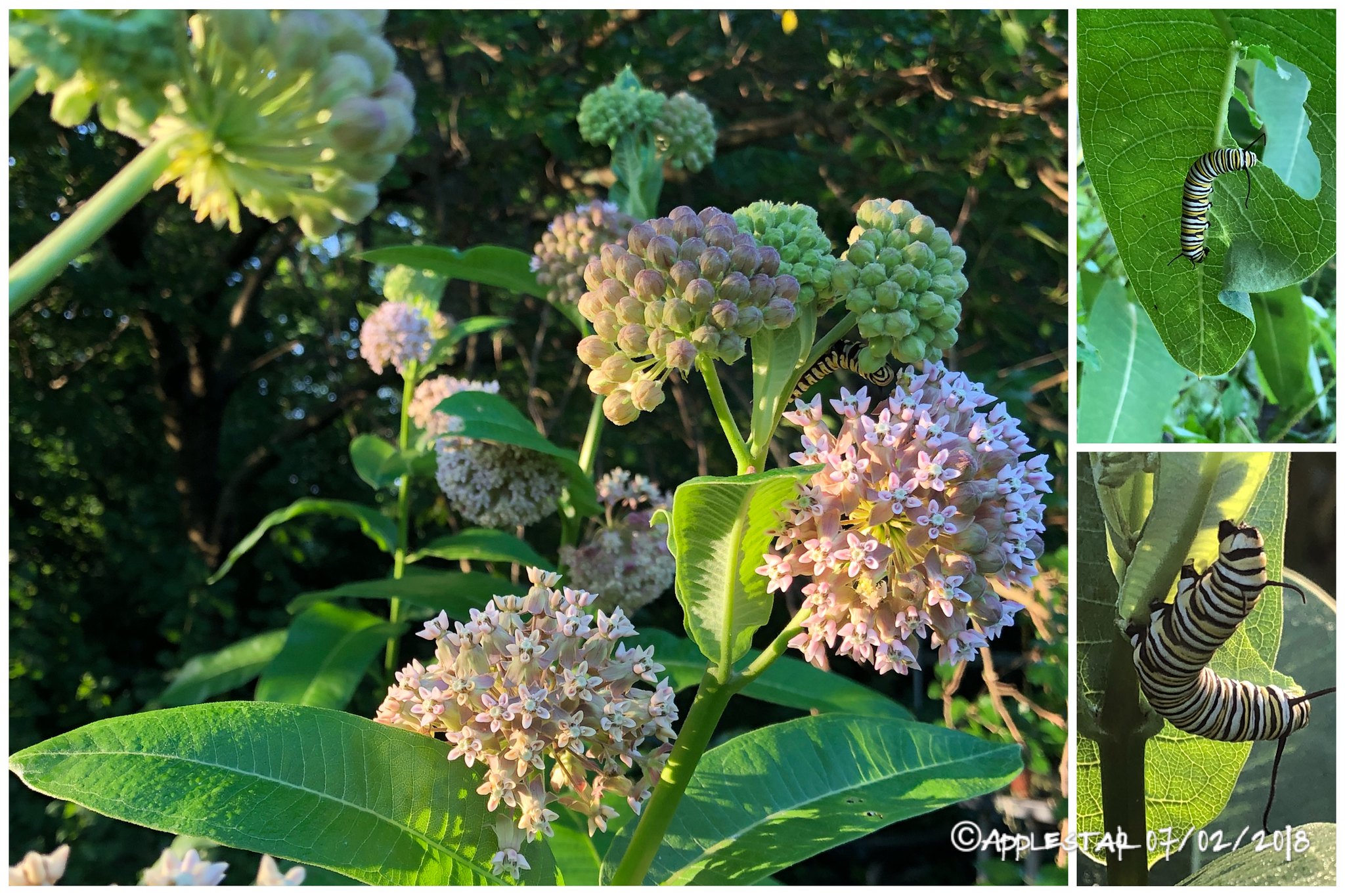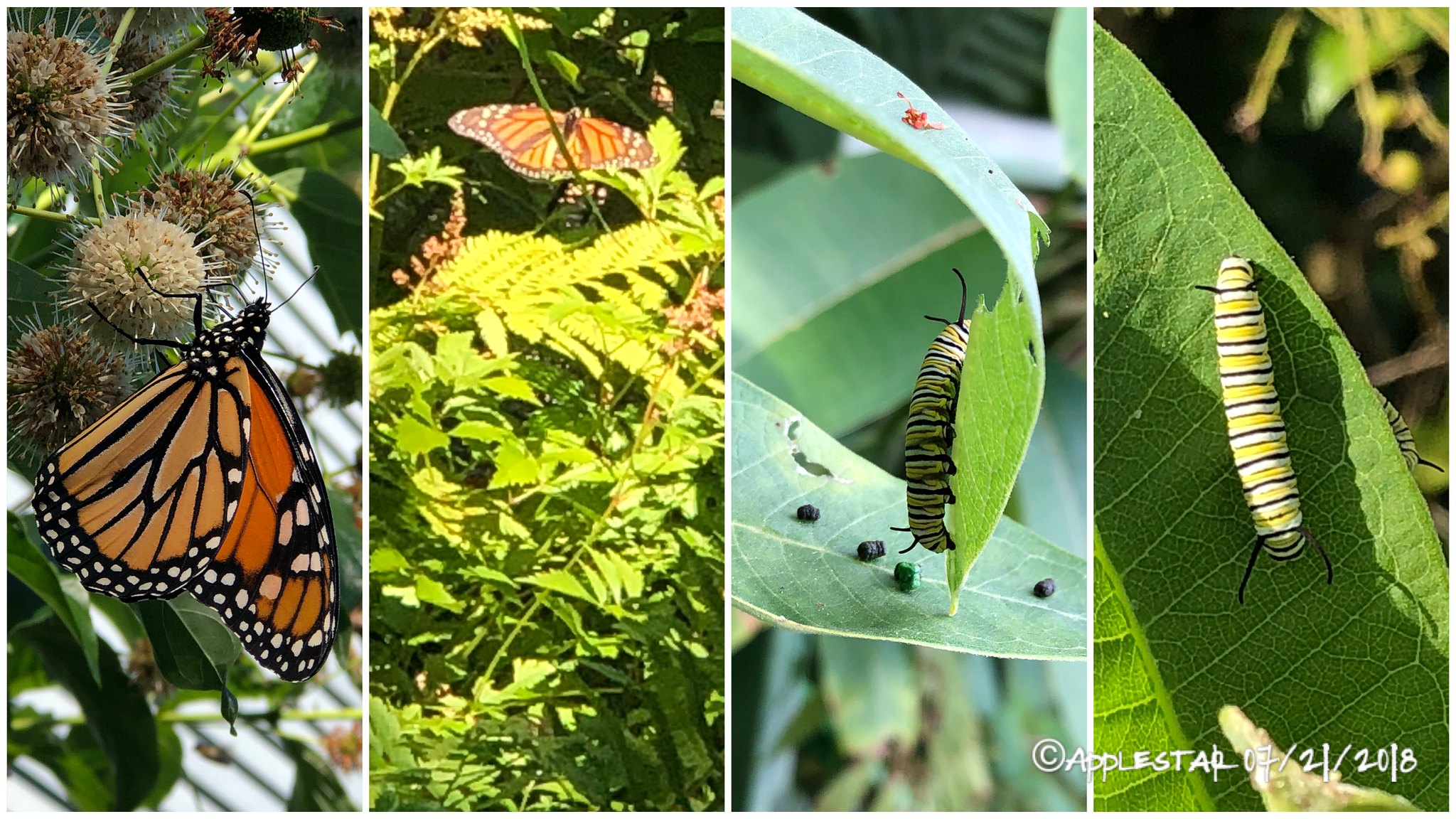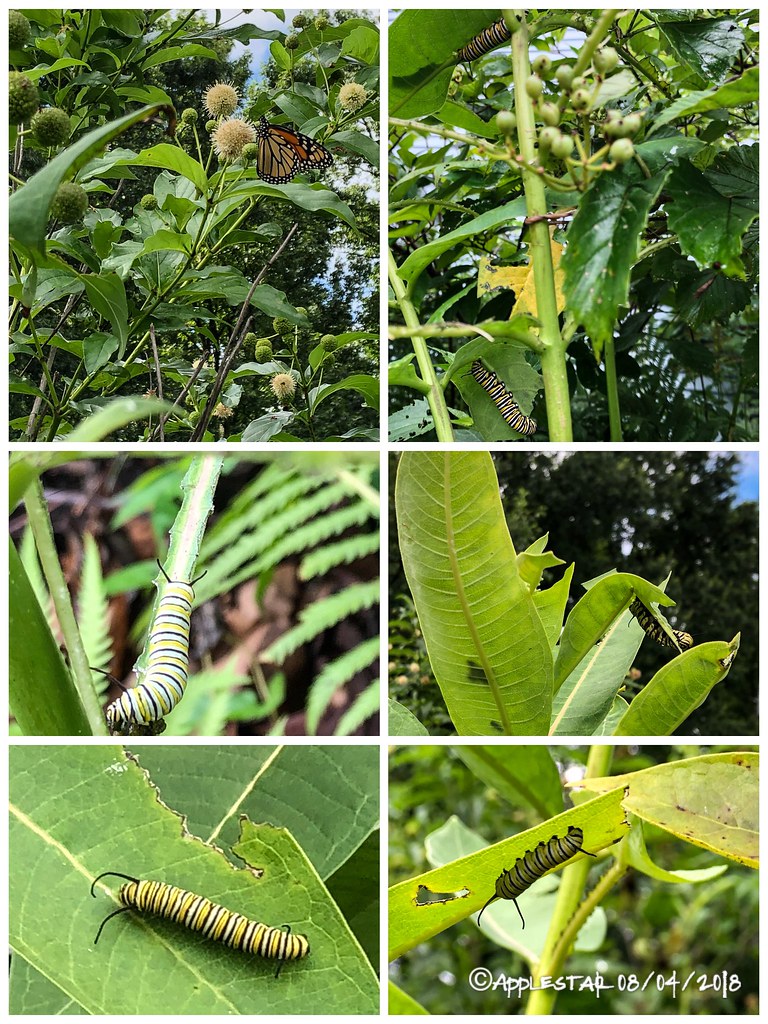- applestar
- Mod
- Posts: 30882
- Joined: Thu May 01, 2008 7:21 pm
- Location: Zone 6, NJ (3/M)4/E ~ 10/M(11/B)
2018 Monarch Butterflies
So excited! There was a large (migration size) female Monarch Butterfly visiting my common milkweed stands around the pond this afternoon 
- applestar
- Mod
- Posts: 30882
- Joined: Thu May 01, 2008 7:21 pm
- Location: Zone 6, NJ (3/M)4/E ~ 10/M(11/B)
In the past as some of you know, I participated in an annual project to collect Monarch butterfly eggs and caterpillars, and raise them in protected indoor environment to tag and release as butterflies. Since I was doing this as part of my children’s summer science projects, I was careful to research and learn everything I could, including how to identify dieseases by observation of caterpillar behavior and examining butterfly wing and abdomen scales under the microscope, and to teach my DD’s that it is necessary to cull and euthanize the diseased caterpillars and even butterflies that managed to grow to term. When we were doing this, the number of butterflies we released basically doubled each year.
But over the years, I noted the differences in the growth rate of the caterpillars and butterflies and began to suspect and attribute the difference to the coddled indoor vs. harsher outdoor climates. This uncertainty factor combined with my growing children’s waning enthusiasm and my own circumstances that made it difficult to continue. So I have not been bringing them indoors for a few years.
But the number of butterflies returning to my garden declined, and while I attributed this to the natural disaster in their wintering grounds in Mexico, and other factors that is causing overall loss in the Monarch population, it made me wonder if I should “help” more of the Monarchs that are entrusted to my garden to grow up to be butterflies. So I have tried different ways to protect them, including placing a pop-up laundry hamper over milkweed to exclude predators. (BTW I don’t use Bt in my garden despite crop losses so as not to endanger the Monarchs).
This year, I’m seeing more caterpillars and some of them have already turned into butterflies. With any luck, they will stay and lay eggs and more generations of summer Monarchs will grow here.
I was having another doubting moment about whether to try to collect eggs and caterpillars or not, and found this article:
Are We Loving Monarchs to Death? - The Crux
https://blogs.discovermagazine.com/crux/ ... 1WeaBopCfA
...I guess I’ll continue to monitor the Monarchs in my garden and do what I can to help them along.
But over the years, I noted the differences in the growth rate of the caterpillars and butterflies and began to suspect and attribute the difference to the coddled indoor vs. harsher outdoor climates. This uncertainty factor combined with my growing children’s waning enthusiasm and my own circumstances that made it difficult to continue. So I have not been bringing them indoors for a few years.
But the number of butterflies returning to my garden declined, and while I attributed this to the natural disaster in their wintering grounds in Mexico, and other factors that is causing overall loss in the Monarch population, it made me wonder if I should “help” more of the Monarchs that are entrusted to my garden to grow up to be butterflies. So I have tried different ways to protect them, including placing a pop-up laundry hamper over milkweed to exclude predators. (BTW I don’t use Bt in my garden despite crop losses so as not to endanger the Monarchs).
This year, I’m seeing more caterpillars and some of them have already turned into butterflies. With any luck, they will stay and lay eggs and more generations of summer Monarchs will grow here.
I was having another doubting moment about whether to try to collect eggs and caterpillars or not, and found this article:
Are We Loving Monarchs to Death? - The Crux
https://blogs.discovermagazine.com/crux/ ... 1WeaBopCfA
...I guess I’ll continue to monitor the Monarchs in my garden and do what I can to help them along.
- applestar
- Mod
- Posts: 30882
- Joined: Thu May 01, 2008 7:21 pm
- Location: Zone 6, NJ (3/M)4/E ~ 10/M(11/B)
I see them every day. Since they are not tagged, there is no way to tell if they are same ones claiming territory and sticking around or resting up before moving on, or freshly enclosed that morning. I saw these today —
Some make it and grow up to be a beautiful butterfly
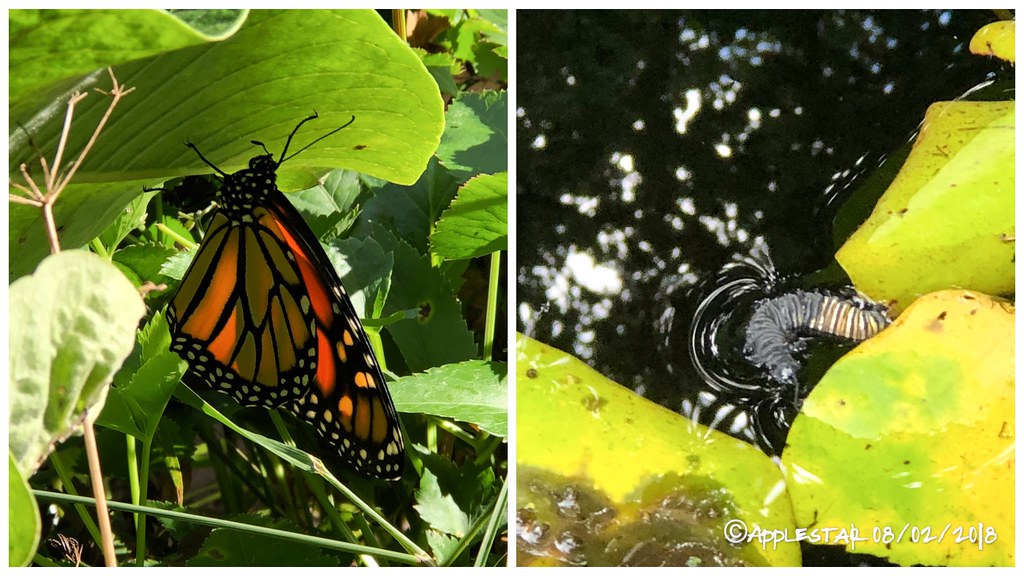 ...some don’t....
...some don’t.... 
...I’m also seeing fresh-looking Tiger Swallowtails. I’m not as good at telling if these are freshly eclosed. They are largest butterflies I see in my garden and very impressive.
A little while ago, I was watching one sunning at the top of a tomato vine with my birding binocs, and within that narrow binocular’s field of view, a tiny green hummingbird hurtled herself at the butterfly for some completely inexplicable reason. ... The Tiger fluttered away unharmed, however. Maybe the Hummer thought the Tiger was a huge yellow blossom she had previously missed...?
... The Tiger fluttered away unharmed, however. Maybe the Hummer thought the Tiger was a huge yellow blossom she had previously missed...?
Some make it and grow up to be a beautiful butterfly
 ...some don’t....
...some don’t.... ...I’m also seeing fresh-looking Tiger Swallowtails. I’m not as good at telling if these are freshly eclosed. They are largest butterflies I see in my garden and very impressive.
A little while ago, I was watching one sunning at the top of a tomato vine with my birding binocs, and within that narrow binocular’s field of view, a tiny green hummingbird hurtled herself at the butterfly for some completely inexplicable reason.
- applestar
- Mod
- Posts: 30882
- Joined: Thu May 01, 2008 7:21 pm
- Location: Zone 6, NJ (3/M)4/E ~ 10/M(11/B)
Yesterday I saw another Monarch butterfly — a Male — sunning on top of a tomato vine ...definitely a post eclosure behavior.
Today I was on the other side of the house when I heard my motion sensor alert chiming, so I went over to the VG beds to see if it is a chipmunk as I am starting to suspect. But instead, I saw another freshly eclosed Monarch butterfly, sunning on a nearby broccoli plant.
The motion sensor is sold as door entry chime — I had fun imagining this Monarch had rang the “door bell” to announce it was visiting or had come out of its chrysalis. “Hi! I’m HERE!”
Today I was on the other side of the house when I heard my motion sensor alert chiming, so I went over to the VG beds to see if it is a chipmunk as I am starting to suspect. But instead, I saw another freshly eclosed Monarch butterfly, sunning on a nearby broccoli plant.
The motion sensor is sold as door entry chime — I had fun imagining this Monarch had rang the “door bell” to announce it was visiting or had come out of its chrysalis. “Hi! I’m HERE!”
- applestar
- Mod
- Posts: 30882
- Joined: Thu May 01, 2008 7:21 pm
- Location: Zone 6, NJ (3/M)4/E ~ 10/M(11/B)
I walked around the corner from the patio this morning and was astonished to find my Cinderella swamp milkweed (Asclepias incarnata) nearly completely defoliated. 

Until this year, the Monarch butterflies that have laid eggs in my garden have preferred the Common Milkweed (Asclepias syriaca). I would only occasionally...very rarely...find a single caterpillar feeding on the swamp milkweed.
Consequently, this clump of very well and sedately behaved milkweed has been lush and full every year, and quietly have increased in size, and only spread across the path to grow one other clump. Only issues they have had was the yellow milkweed aphids infesting the tender upper growths.
However, I knew that regionally, there are other Monarch waystations which have reported that their Monarchs preferred swamp milkweed over common milkweed.
I think this must mean that the Monarch Mom to these 5 caterpillars must have grown up on swamp milkweed and maybe generations before her as well, imprinting swamp milkweed as the preferred food source in her memory.

Until this year, the Monarch butterflies that have laid eggs in my garden have preferred the Common Milkweed (Asclepias syriaca). I would only occasionally...very rarely...find a single caterpillar feeding on the swamp milkweed.
Consequently, this clump of very well and sedately behaved milkweed has been lush and full every year, and quietly have increased in size, and only spread across the path to grow one other clump. Only issues they have had was the yellow milkweed aphids infesting the tender upper growths.
However, I knew that regionally, there are other Monarch waystations which have reported that their Monarchs preferred swamp milkweed over common milkweed.
I think this must mean that the Monarch Mom to these 5 caterpillars must have grown up on swamp milkweed and maybe generations before her as well, imprinting swamp milkweed as the preferred food source in her memory.
- applestar
- Mod
- Posts: 30882
- Joined: Thu May 01, 2008 7:21 pm
- Location: Zone 6, NJ (3/M)4/E ~ 10/M(11/B)
Yesterday I saw a Monarch butterfly in one of the common milkweed patches, but when I focused on its fluttering form, I realized it was struggling — exhaustion evident in the weak and unevenly beating wing strokes. When it landed on a milkweed leaf, I verified that it was a female as I suspected. And at next landing, I watched closely and saw her reach under the leaf with end of her abdomen. After she tottered off, I ducked and peered under the leaf to check, and sure enough there was a freshly laid egg.
I was cheering her on after that, but was sorry to see how worn out she was. So it cheered ME up a bit later on to see a freshly eclosed Monarch butterfly. It was too fast and didn’t land so I couldn’t visually gender it, but it felt good to know another healthy one has grown up and joined the rest of the population from my waystation.
I was cheering her on after that, but was sorry to see how worn out she was. So it cheered ME up a bit later on to see a freshly eclosed Monarch butterfly. It was too fast and didn’t land so I couldn’t visually gender it, but it felt good to know another healthy one has grown up and joined the rest of the population from my waystation.

- applestar
- Mod
- Posts: 30882
- Joined: Thu May 01, 2008 7:21 pm
- Location: Zone 6, NJ (3/M)4/E ~ 10/M(11/B)
Saw 2 Monarch butterflies on Tues.14th while in the garden, including this wing-damaged one:
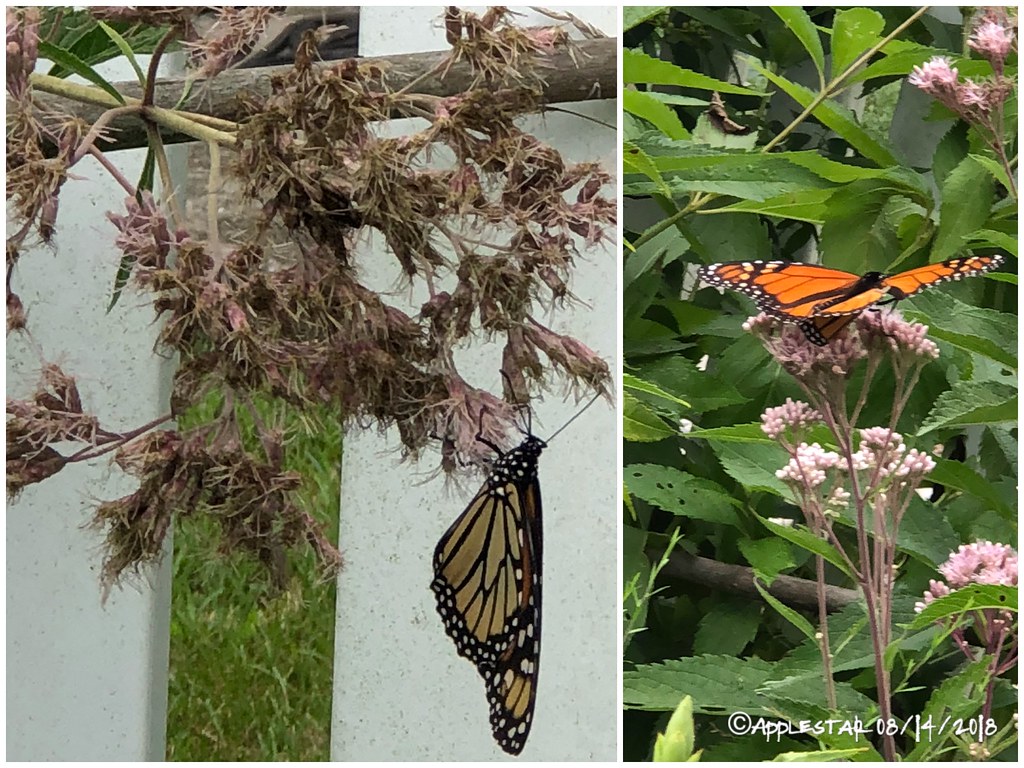
...saw the wing-damaged one again on Wed. and noted that it is a male. It was flying over the Enterprise apple tree and the blackberries on the other side of the house
...saw 3 monarchs on Thurs. and one of them was the wing-damaged male flying territorial sweeps over the Spiral Garden area
,,,saw THREE butterflies yesterday and yes, the wing-damaged male was still here.
...and again today.
It’s likely the male was injured during one of those “fierce” aerial territorial battles. I wonder if the male had eclosed here and has been claiming the garden ever since, or he has been staying because he was injured here? I have noticed injured, easy to differentiate butterflies staying in the garden like this before.

...saw the wing-damaged one again on Wed. and noted that it is a male. It was flying over the Enterprise apple tree and the blackberries on the other side of the house
...saw 3 monarchs on Thurs. and one of them was the wing-damaged male flying territorial sweeps over the Spiral Garden area
,,,saw THREE butterflies yesterday and yes, the wing-damaged male was still here.
...and again today.
It’s likely the male was injured during one of those “fierce” aerial territorial battles. I wonder if the male had eclosed here and has been claiming the garden ever since, or he has been staying because he was injured here? I have noticed injured, easy to differentiate butterflies staying in the garden like this before.
- applestar
- Mod
- Posts: 30882
- Joined: Thu May 01, 2008 7:21 pm
- Location: Zone 6, NJ (3/M)4/E ~ 10/M(11/B)
I see Wing-D out there still today, sipping from the Joe Pye-weed with another Monarch butterfly. A hummingbird that was enjoying the nearby red cardinal flowers swooped over to him but pulled up before poking at him (whew) — I really think the hummers just go after anything bright colored just in case they missed a flower or a new flower had opened up.... not rare occurrence to have them do a dive or fly-by at me and then chitter at me in annoyance for not being a flower. LOL
I need to go deadhead the JPW — those 4-5 foot plants are beloved by butterflies and are great in the back of my fence-corner bog garden where I can see it from my bedroom window with my birding binocs. There are only a couple of fresh floral heads left, but if I deadhead them, more will start to bloom.
I need to go deadhead the JPW — those 4-5 foot plants are beloved by butterflies and are great in the back of my fence-corner bog garden where I can see it from my bedroom window with my birding binocs. There are only a couple of fresh floral heads left, but if I deadhead them, more will start to bloom.
- applestar
- Mod
- Posts: 30882
- Joined: Thu May 01, 2008 7:21 pm
- Location: Zone 6, NJ (3/M)4/E ~ 10/M(11/B)
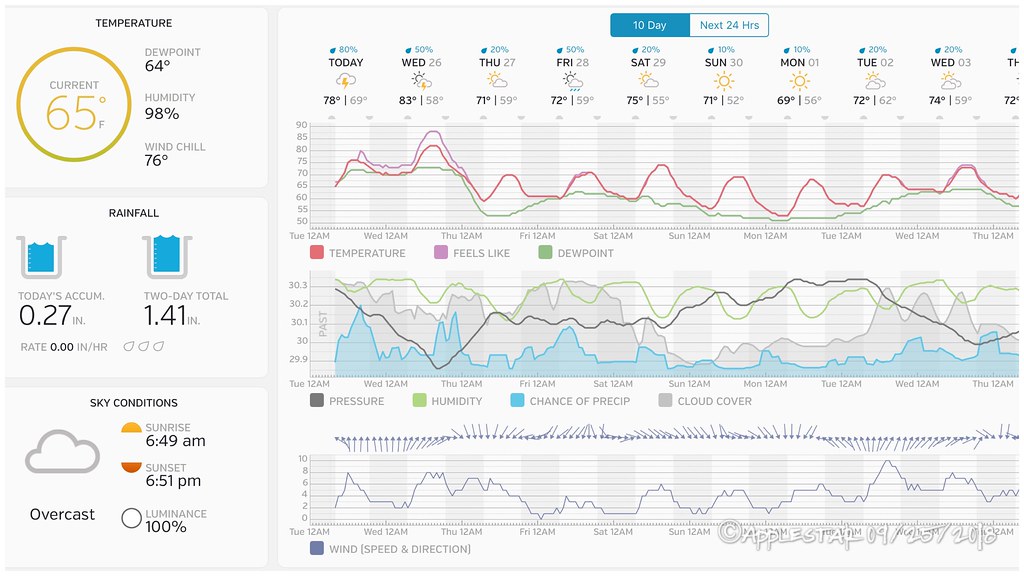
We are solidly in the fall weather patterns now, with daily chance of rain and night temp dropping in the 50’s.
This is the time of the season when the Eastern seaboard annual Monarch Butterfly migration that fly along the Atlantic coastal route funnels through NJ’s Cape May Point in their southward journey, and make their flight over the Delaware Bay to DelMarVa (I don’t know if there is a central location where they end up in one of those states).
My garden is too far inland and closer to the Delaware River to actually see a kaleidoscope of them fly through. And I think the Monarch butterflies that are born in my garden probably splits and head in 3 different directions, depending on their genetically imprinted memory/instinct passed down from their... mother? father too?—
- flying east/southeast over the Pine Barrens to join the coastal tributary group,
- flying south along the Delaware River either on the NJ side or the Pennsylvania side to reach Delaware, and
- flying west across the river and across Pennsylvania to join the much larger main central southward migration, heading directly to Texas.
I imagine there are sub streams within the Atlantic coastal migration route that fly over bays and islands, or stay on the mainland coastline as they fly south.
I have heard that on reaching Florida, the coastal migration divide into groups that
- fly along the Gulf of Mexico to joint the migration in Texas and Mexico (where they divide into group that stay in Texas and group that make the final leg of the journey to Mexican wintering grounds via the Texas funnel)
- Stay and overwinter in Florida
- Make the grand flight over Gulf of Mexico directly to the Yucatán peninsula
I was looking out of the window yesterday when it was sunny and breezy, wondering if there are any Monarchs left in my garden, and (as so often happens) the garden “answered” — I spotted a Monarch butterfly male slowly flapping his wings as he clung to and sipped from a bright yellow Jerusalem artichoke/sunchoke flower swaying in the wind in the front yard. The patch is in full bloom right now (and at least 40 feet from any milkweed, so I don’t if it was a freshly eclosed butterfly that grew up in my garden, or one that flew in and stopped by on his way south).
Return to “Wildlife - Gardening with Local Critters in Mind”

